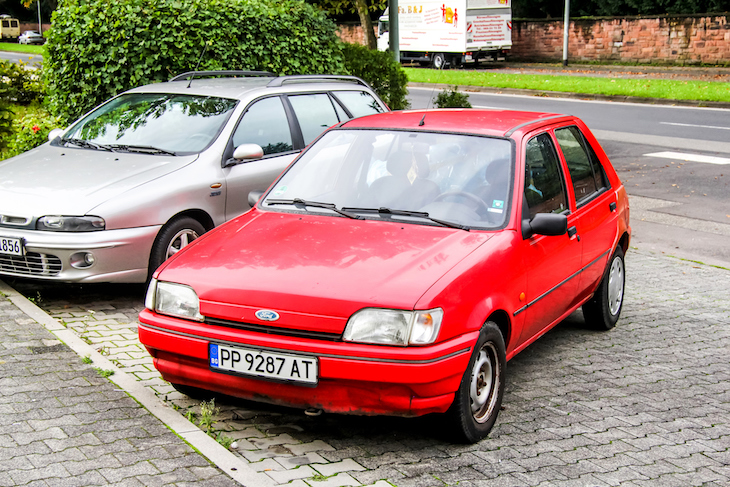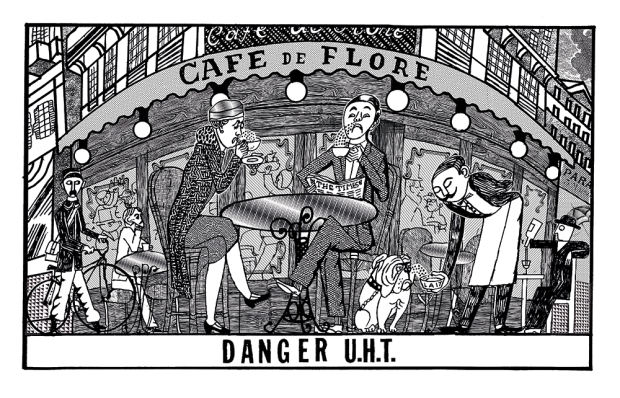I was collecting my daughter from school when my path was blocked by an enormous black Range Rover sitting in the middle of the road. As I squeezed past, one tyre on the pavement, I opened my window and asked, as gently as I could: ‘Why don’t you drive on your side of the road?’ The woman looked down from on high and said: ‘Why are you driving a banger?’
I’ve been trying to come up with a clever response ever since. I’d never thought of my car as a banger before. It’s a nearly 20-year-old Ford Focus, in excellent condition for its age with just a touch of rust on the boot lid. But by modern standards I suppose it is. Nearly everyone else on the road seems to have a new Range Rover like the charming lady from school, a Mini or a shiny German car. Either that or it’s Uber drivers silently gliding around in their Priuses. You now see more prestige cars than ordinary ones.
Things were very different when I grew up in the 1980s. It was a glorious time; bangers were everywhere. My father had a Fiat Regata estate that was more rust than paint. The middle-class car of choice wasn’t the gleaming black Range Rover, but a beaten-up Volvo 240 that smelt of dog. A shiny new car was considered a bit naff back then. One father at school had a 1970s Aston that he never washed. Most wonderful of all were the old Jags that looked like they’d been used for one bank job too many.
So what happened? Well, many of these old cars weren’t that old. They were relics of Britain’s dysfunctional 1970s motor industry — Triumph Dolomites, Austin Allegros and Morris Marinas, slowly or not so slowly heading for the scrapheap. Then again most cars, Germans and Japanese excepted, weren’t very well made. Our Fiat Regata probably wasn’t more than five years old. Modern cars are more reliable, the bodywork galvanised to prevent rust, so cars look new for much longer. Moreover, the values of classic cars have gone up so much that nobody is going to let their Aston Martin fall into aristocratic decrepitude.
But the real nail in the coffin for the great British banger is something called PCP. No, I’m not talking about phencyclidine aka angel dust, but Personal Contract Purchase. You put down a small deposit and then pay monthly for your new car. Often you don’t need a deposit at all, and it’s not hard to get finance even with a bad credit history. Anyone can, for a time, drive around in a luxury car. Mercedes has doubled its UK sales since 2010 and PCP is what keeps Britain’s booming automobile industry going.
You don’t actually own the car, and at the end of the contract you can either upgrade or buy it outright. The PCP industry is built on two unstable foundations: rock-bottom interest rates and a buoyant second-hand car market. The market is becoming saturated with used cars because people upgrade sooner than they would if buying outright. Then there’s the great diesel time bomb. Many of these cars are diesels, which — due to growing awareness of how poisonous they are — are becoming unsellable. What is more, these debts are being resold as asset-backed securities just as with the subprime mortgage crisis of 2008. No wonder the Bank of England issued a warning last year about PCP. As you might expect, it’s an even bigger problem in the US.
I like to think that the rude lady in her Range Rover was one missed payment away from repossession. At least I own my car. Even if I had the money, I don’t think I’d buy a new car, outright or on credit. Let’s face it, with very few exceptions, modern cars are hideous. Crash regulations have made them bloated and bulbous. They’re much bigger than cars of yore, the modern Mini looks like an original that ate all the pies. And the less said about SUVs the better. They’re ugly on the inside too. Thick pillars might be safer, but they make cars gloomy places in which to sit. Modern cars beep at the slightest provocation and unnerve you by turning off the ignition automatically at the lights. They’re not so fun to drive either — power steering is now electronic without the feel of the old hydraulic system.
For me, there was a sweet time for cars in the 1990s when they were reliable, economical, fast and safe but before technology took over. Mine can be repaired by any garage. It costs little to insure and it’s so old I don’t mind if it gets scraped on narrow roads.
My car is also much less toxic than those about-to-be-worthless diesels. Also, don’t forget that any new car uses a lot of energy in its creation: the Prius in particular has a massively energy-intensive production process.
Anyway, forget the practicalities. There’s something cavalier about driving an old car —even a B-reg Vauxhall Cavalier. I love the man in Deptford who wafts around in an 1980s Bentley Mulsanne that looks like it’ll struggle to pass its MOT.
Bangers add character to the road. When everyone has a new car it’s boring driving around. Which is why I relish trips to LA, where the dry climate keeps all kinds of esoterica in good condition: 1970s muscle cars, 1960s British sports cars and dozens of gold Mercs are a common sight. My American wife’s grandmother has a beautiful early 1990s Cadillac with a 5.4 litre V8 engine that purrs. Just don’t try driving it over 70 mph, as it starts wallowing like a boat.
Prices for certain classics may have gone through the roof, but secondhand cars on the whole are ridiculously cheap. My old Ford won’t last for ever. It’s worth so little money that when it does need major repairs it will be simpler to scrap it, so I’m looking around for another, perhaps more glamorous banger. I saw a tidy Mercedes 500 SEC, probably the prettiest luxury car of the 1980s, advertised for £5,000. Wouldn’t you rather have one of those than a Nissan Qashqai?
Which brings me on to what I should have replied to the Range Rover lady: ‘It’s not a banger, it’s a classic of the future.’ That would have showed her.
Got something to add? Join the discussion and comment below.
Get 10 issues for just $10
Subscribe to The Spectator Australia today for the next 10 magazine issues, plus full online access, for just $10.
You might disagree with half of it, but you’ll enjoy reading all of it. Try your first month for free, then just $2 a week for the remainder of your first year.














Comments
Don't miss out
Join the conversation with other Spectator Australia readers. Subscribe to leave a comment.
SUBSCRIBEAlready a subscriber? Log in